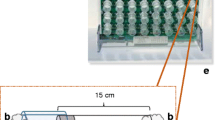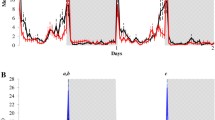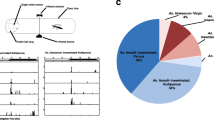Abstract
Flight, walking and resting behaviours of male Aedes albopictus (Skuse) were observed in a flight cage. These behaviours were also associated with repetitive acts of grooming. The effects of sugar meal and period of the day on the total duration, the frequency and the duration of each individual grooming behaviour were studied. Fed or unfed males were individually released in a transparent plastic flight cage and direct visual observations using Observer software were carried out for 2 h during the morning and 2 h in the afternoon. There was no significant difference in the grooming behaviour between morning and afternoon observations. Fed male mosquitoes groomed longer than unfed males. The sugar meal seemed an important influencing factor of the grooming behaviour by giving more energy and making different parts of the mosquito sticky. The functions of grooming behaviour are discussed in regard to other behaviours such as mating, copulation, sensory detection and flight.


Similar content being viewed by others
References
Barber GW, Starnes EB (1949) The activity of house flies. J N Y Entomol Soc 57:203–214
Benedict M, Levine RS, Hawley W, Lounibos LP (2007) Spread of the tiger: global risk of invasion by the mosquito Aedes albopictus. Vect Borne Zoon Dis 7:76–85. doi:10.1089/vbz.2006.0562
Bonilauri P, Bellini R, Calzolari M, Angeflni R et al (2008) Chikungunya virus in Aedes albopictus, Italy. Emerg Infect Dis 14:852–854
Boyer S, Gilles J, Merancienne D, Fontenille D, Lemperiere G (2011) Sexual performance of male Aedes albopictus (Diptera: Culicidae). Med Vet Entomol 25:454–459. doi:10.1111/j.1365-2915.2011.00962.x
Cator LJ, Arthur BJ, Harrington LC, Hoy RR (2009) Harmonic convergence in the love songs of the dengue vector mosquito. Science 323:1077–1079. doi:10.1126/science.1166541
Delatte H, Paupy C, Dehecq JS, Thiria J, Failloux AB, Fontenille D (2008) Aedes albopictus, vector of chikungunya and dengue viruses in Reunion Island: biology and control. Parasite J Soc Française Parasitol 15:3–13
Delatte H, Desvars A, Bouetard A, Bord S, Gimonneau G, Vourc’h G, Fontenille D (2010) Blood-feeding behavior of Aedes albopictus, a vector of Chikungunya on La Reunion. Vect Borne Zoon Dis 10:249–258. doi:10.1089/vbz.2009.0026
Dillwith JW, Blomquist GJ (1982) Site of sex pheromone biosynthesis in the female house fly, Musca domestica. Experientia 38:471–473
Drummond FA, Logan PA, Casagrande RA, Gregson FA (1985) Host specificity tests of Chrysomelobia labidomerae, a mite parasitic on the Colorado potato beetle. Int J Acarol 11:169–172
Eaton RC, Farley RD (1969) The neural control of cercal grooming behavior in the cockroach Periplaneta americana. J Insect Physiol 15:1047–1056
Goldman LJ, Callahan PS, Carlysle TC (1972) Tibial combs and proboscis cleaning in mosquitoes. Annu Rev Entomol Soc Am 65:1299–1302
Golenda CF, Forgash A (1986) Grooming behavior in response to fenvalerate treatment in pyrethroid-resistant houseflies. Entomol Exp Appl 40:169–175
Gratz NG (2004) Critical review of the vector status of Aedes albopictus. Med Vet Entomol 18:215–227. doi:10.1111/j.0269-283X.2004.00513.x
Hlavac TF (1975) Grooming systems of insects—structure, mechanics. Annu Entomol Soc Am 68:823–826
Jander R (1976) Grooming and pollen manipulation in bees (Apoidea)—nature and evolution of movements involving foreleg. Physiol Entomol 1:179–194
Jander R, Jander U (1978) Wing grooming in bees (Apoidea) and the evolution of wing grooming in insects. J Kansas Entomol Soc 51:653–665
Kumar NP, Mitha MM, Krishnamoorthy N, Kamaraj T, Joseph R, Jambulingam P (2007) Genotyping of virus involved in the 2006 Chikungunya outbreak in South India (Kerala and Puducherry). Curr Sci 93:1412–1416
Lang JT (1977) Contact sex pheromone in the mosquito Culiseta inornata (Diptera: Culicidae). J Med Entomol 14:448–454
Lang JT, Foster WA (1976) Is there a female sex pheromone in the mosquito Culiseta inornata. Environ Entomol 5:1109–1115
Linley JR, Adams GM (1972) A study of the mating behaviour of Culicoides melleus (Coquillett) (Diptera: Ceratopogonidae). Trans Entomol Soc Lond 124:81–121
Mc Iver SB (1982) Sensilla of mosquitoes (Diptera: Culicidae). J Med Entomol 19:489–535
Paupy C, Delatte H, Bagny L, Corbel V, Fontenille D (2009) Aedes albopictus, an arbovirus vector: from the darkness to the light. Microbes Infect 11:1177–1185
Paupy C, Ollomo B, Kamgang B, Moutailler S et al (2010) Comparative role of Aedes albopictus and Aedes aegypti in the emergence of dengue and chikungunya in Central Africa. Vect Borne Zoon Dis 10:259–266. doi:10.1089/vbz.2009.0005
Peyrefitte C, Rousset D, Pastorino B, Pouillot R et al (2006) Chikungunya virus, Cameroon, 2006. Emerg Infect Dis 13:768–771
R Development Core Team (2009) R: a language and environment for statistical computing. R Foundation for Statistical Computing, Vienna. http://www.R-project.org
Reingold SC, Camhi JM (1977) A quantitative analysis of rhythmic leg movements during three different behaviors in cockroach, Periplaneta americana L. J Insect Physiol 23:1407–1420
Reingold SC, Camhi JM (1978) Abdominal grooming in cockroach—development of an adult behavior. J Insect Physiol 24:101–110
Schuffenecker I, Iteman I, Michault A, Murri S et al (2006) Genome microevolution of chikungunya viruses causing the Indian Ocean outbreak. PLoS Med 3:1–13. doi:10.1371/journal.pmed.0030263
Sergon K, Njuguna C, Kalani R, Ofula V et al (2008) Seroprevalence of chikungunya virus (CHIKV) infection on Lamu Island, Kenya, October. Am J Trop Med Hyg 78:333–337
Skuse F (1894) The banded mosquito of Bengal. Indian Museum Notes 3:20
Slifer EH (1962) Sensory hairs with permeable tips on the tarsi of the yellow fever mosquito, Aedes aegypti. Annu Entomol Soc Am 55:531–535
Szebenyi AL (1969) Cleaning behavior in Drosophila melanogaster. Anim Behav 17:641–651
Valentine BD (1973) Grooming behavior in Coleoptera. Coleoptera Bull 27:63–73
Walker ED, Archer WE (1988) Sequential organization of grooming behaviors of the mosquito, Aedes triseriatus. J Insect Behav 1:97–109
Wallis RC (1954) A study of oviposition activity of mosquitoes. Am J Hyg 60:135–168
Yanagawa A, Shimizu S (2007) Resistance of the termite, Coptotermes formosanus Shiraki to Metarhizium anisopliae due to grooming. Biocontrol 52:75–85. doi:10.1007/s10526-006-9020-x
Acknowledgments
We thank Lucie Maillot for her help during the laboratory work. The IRD Sterile Insect Technique Project was financially supported by the French Ministry of Health and the FEDER Convergence Réunion 2007-2012 programme.
Author information
Authors and Affiliations
Corresponding author
Rights and permissions
About this article
Cite this article
Jacquet, M., Lebon, C., Lemperiere, G. et al. Behavioural functions of grooming in male Aedes albopictus (Diptera: Culicidae), the Asian tiger mosquito. Appl Entomol Zool 47, 359–363 (2012). https://doi.org/10.1007/s13355-012-0126-6
Received:
Accepted:
Published:
Issue Date:
DOI: https://doi.org/10.1007/s13355-012-0126-6




